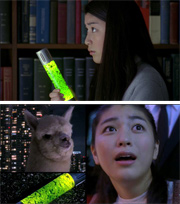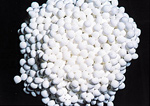2nd Generation "Kuraray-Chan" meets Riko Narumi Protecting the Material X in the Kuraray Group's New "Mirabakesso" TV Commercial Corporate Commercial: "Who is Kuraray?" Episode Airing in Japan from August 24 (Monday)

As a continuation of the corporate advertising campaign started in November 2007, Kuraray will air a new version of the "Mirabakesso"* TV commercial series on August 24 (Monday).
Actress Riko Narumi and the intriguing alpaca will appear again to seek understanding that Kuraray is "a chemicals manufacturer committed to contributing to the future" using dynamic video much like a movie preview.
The 2nd generation "Kuraray-Chan" appearing in this commercial is an alpaca named Tarakey, who replaces the original alpaca named Hanako.
- *Derived from the campaign phrase "Mirai ni Bakeru Shinsozai" which can be literally translated as "new materials that transform into the future"
1. Summary of the TV Commercial
Title
Kuraray Corporate Commercial "Who is Kuraray?" Episode running 15 and 30 seconds
Start of Broadcast
August 24, 2009 (Monday)
Broadcast Schedule
- TV programming (nationwide)
Gaia no Yoake (Dawn of Gaia) (documentary program on economic subjects, broadcast in affiliation with TV Tokyo Corporation from 10:00pm to 10:54pm every Tuesday) - Commercial Spot Airing Locations
Kanto, Kansai, Niigata, Okayama, Kagawa, Ehime(Japan)
August 24 (Monday) - September 23 (Wednesday)
TV Commercial Storyline
 The mysterious shimmering Material X
The mysterious shimmering Material X
- "Who is Kuraray?" Episode running 15 and 30 seconds
- Material X has been developed by a world-renowned chemist (Riko's father).
A mysterious organization seeks the power hidden in the new material.
Riko (Riko Narumi) has been given Material X by her father to guard it from the organization.
Agents abduct Riko's father and pursue her.
The woman heading the organization wants to know who Kuraray is.
A child genius mumbles, "Chemistry is the answer." Is he an enemy or a friend?
Riko is eventually cornered by the organization.
An alpaca that is a servant of chemistry appears in order to save her.
What will happen to Riko? Who will get Material X?
Production Staff
- Production Company: LIGHT PUBLICITY CO., LTD.
- Creative Director: Nobuyuki Miyadera
- Director: Makoto Sayama
- TV Commercial Concept Developed by the Production Staff
- Planning of the commercial was carried out with the aim to promote understanding that Kuraray is "a chemical manufacturer committed to contributing to the future" in 2009, which is the third year of the campaign. This commercial has been created like a movie preview. The speedy and stylish video and music depict a unique worldview. Against this dynamic backdrop, an attempt was made to effectively and strikingly convey an understanding of Kuraray by inserting phrases including "Mirabakesso," "manufacturer of new materials," "Kuraray," and "chemistry" in the lines of the characters appearing. The storyline is set up with an ending intended to make people interested about the future.
2. Behind the Scenes
Filming took place in Tokyo at the start of August. All scenes in the commercial were shot on-site. The commercial was shot with Riko Narumi running through a variety of locations such as underground passages, office districts and port warehouses. Ms. Narumi did an excellent job of putting her body on the line to escape from the agents in the sweltering heat. The filming that took place in the buffeting wind on the heliport of 9-storey building sparked her spirit as an actress and she did a wonderful job of acting the scene. Ms. Narumi was accompanied by Material X throughout most of the filming. Part of this Material X is actually made up of a real Kuraray product called "PVA Gel." The mysteriously glowing object has much presence in the commercial. In this commercial, the 2nd generation alpaca named Tarakey replaces the original alpaca named Hanako, who was used until the previous episode. In the commercial he plays a giant alpaca, but he is actually only 6 months old. In fact, Tarakey has been recognized as the world's most handsome alpaca by the director of the Peruvian Society of Registered Alpaca and Llama Breeders. Another highlight of the commercial is seeing Ms. Narumi and Tarakey play such a handsome couple.
- About "PVA Gel"
- The PVA gel used in Material X can trap and carry microorganisms. It is made up of small white beads with a diameter of approximately 4mm that were developed by Kuraray ahead of the rest of the world using poval resin. The extremely fine reticulate structure enables each bead to hold up to 1 billion microorganisms. These microorganisms are used in the treatment of industrial wastewater and household wastewater.
|
|
3. Profile of Riko Narumi
 Riko Narumi
Riko Narumi
Riko Narumi was born on August 18, 1992 in Yokohama City, Kanagawa Prefecture. She was cast in her first leading role in the drama "Ruri no Shima" in 2005. In 2007, she starred in a series of films including Shindo, Ashita no Watashi no Tsukurikata and Kimi ni shika Kikoenai. In a drama series titled Hachimitsu to Kuroba, which was aired in 2008, Ms. Narumi played the role of Hagumi Hanamoto. In 2009, she played leading roles in the film Tsumi toka Batsu toka directed by Keralino Sandorovich (real name: Kazumi Kobayashi) and Yamagata Scream directed by Naoto Takenaka, also scheduled to be released in 2009. She will also star in Bushido Sixteen scheduled to be released in spring of 2010.
4. About Alpaca
 Tarakey, the 2nd generation "Kuraray-Chan"
Tarakey, the 2nd generation "Kuraray-Chan"
Alpacas are found mainly in South America. They have been domesticated since the time of the ancient Inca Empire. Alpacas live on grass and moss and grow to reach approximately 2 meters in height and 50 kg in weight. Though hard to imagine from their cute, unique appearance that stays in one's mind at just one glance, they are very cautious and shy.
5. Purpose of the Ad Campaign
Kuraray was established in 1926 as a manufacturer of rayon synthetic fiber. After becoming the first company in the world to successfully commercialize PVA fiber,KURALON. Kuraray has utilized the technology for poval, the material used in creating KURALON, to evolve into a specialty chemical company boasting the world's largest market share for many highly functional materials developed using the company's own technology, such as poval film essential for LCDs used in televisions and PCs, EVAL, a resin distinguished by its excellent gas barrier properties, and CLARINO, a type of manmade leather is in school backs and other applications.
The company currently aims to achieve sustained growth through the expansion of businesses providing solutions to global issues, such as wastewater treatment and reusable energy businesses utilizing the technologies accumulated to date.
This corporate advertising campaign revolving around the television commercials has been conducted to support future growth and boost Kuraray's corporate brand value.
The catchphrase, "Mirai ni Bakeru Shinsozai," was chosen for exactly this reason, which is to show Kuraray's focus on the future progress of both people and the organization. We also tried to create an analogy between the potential of new materials and the potential of youth.

